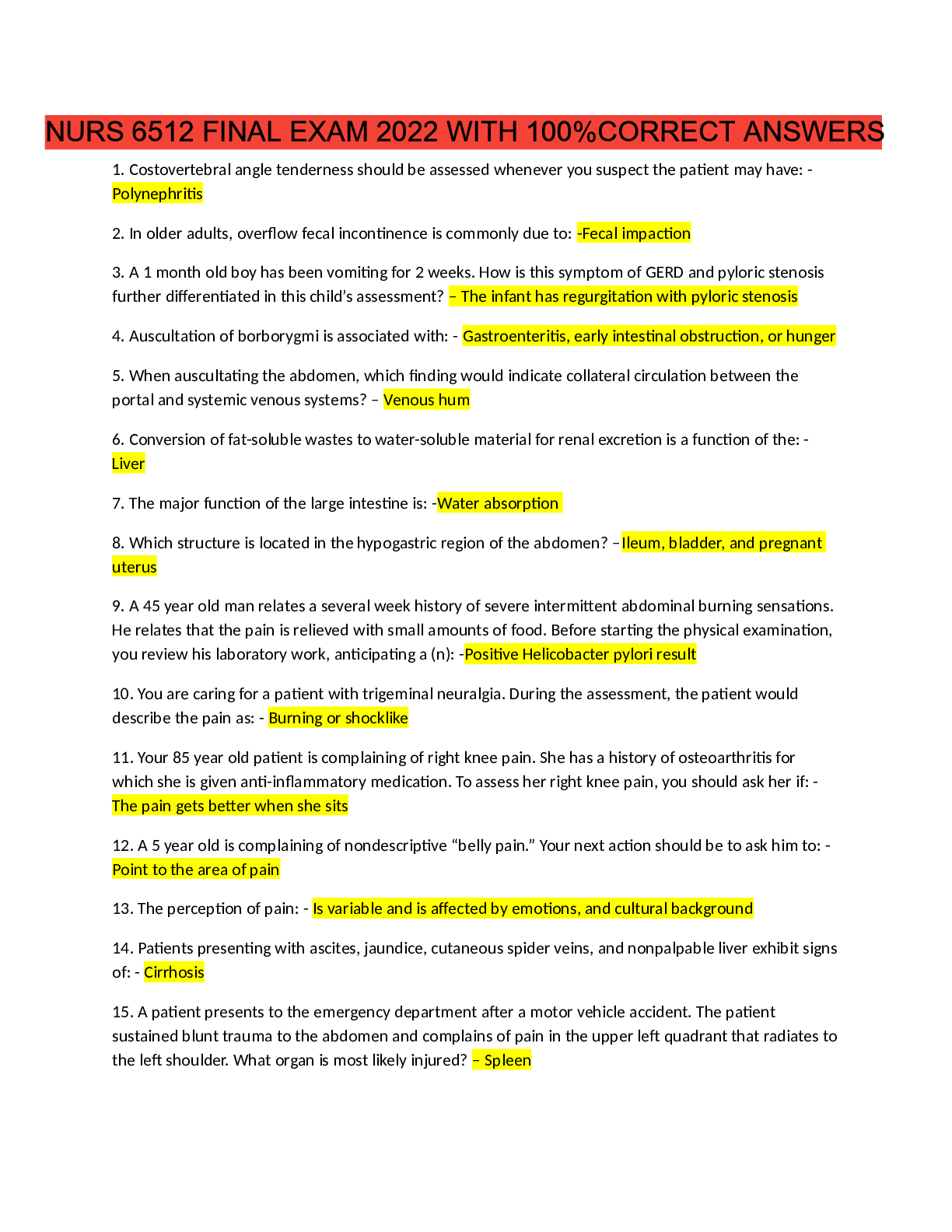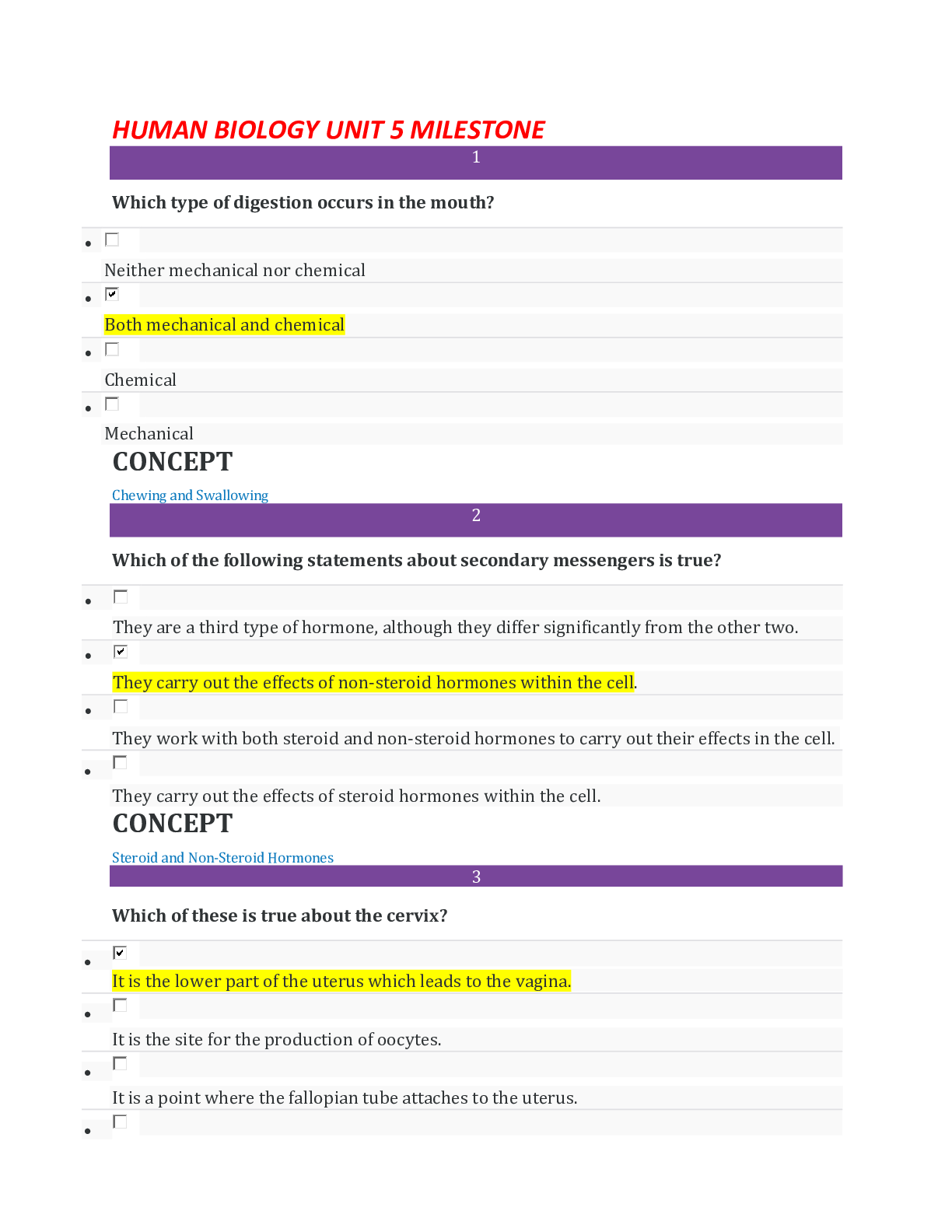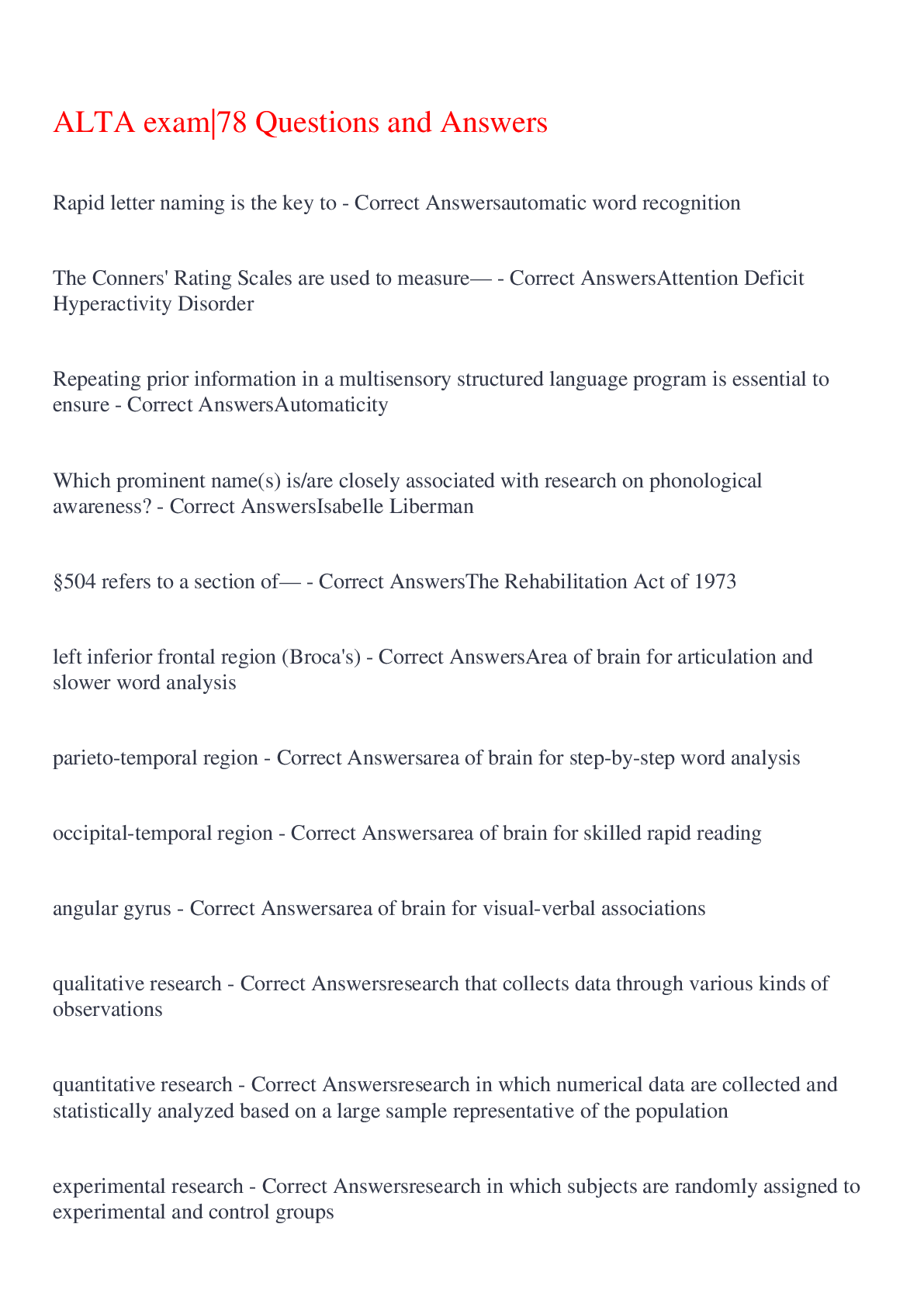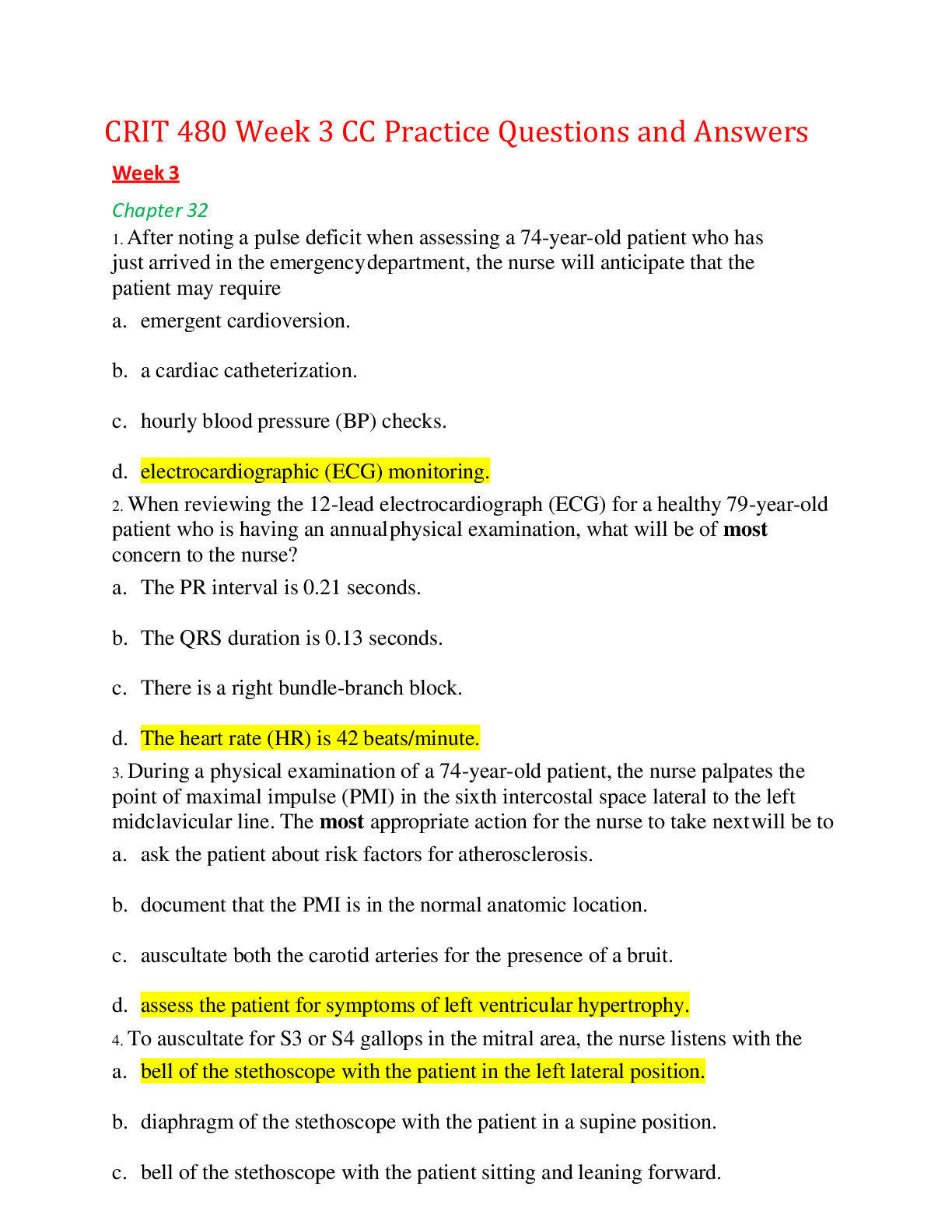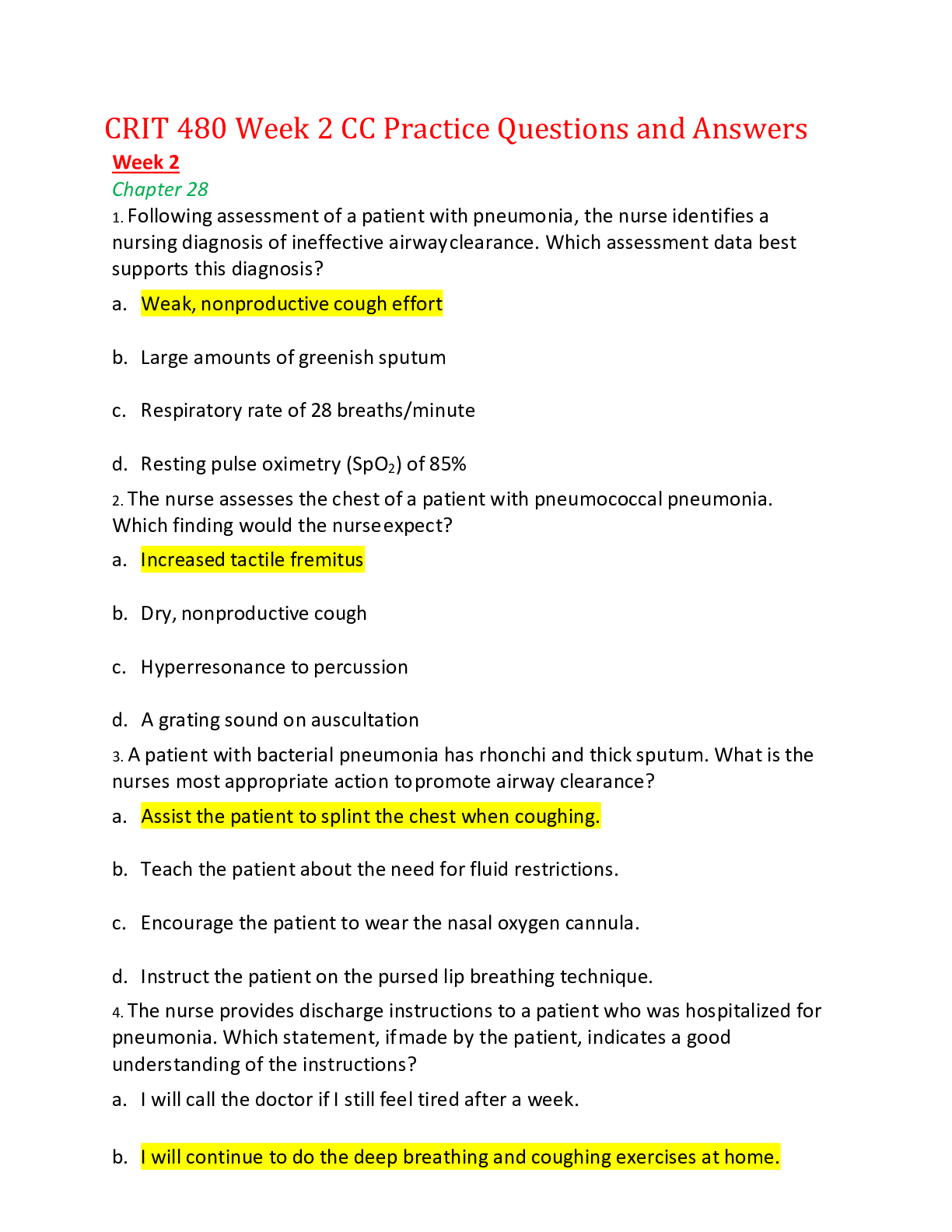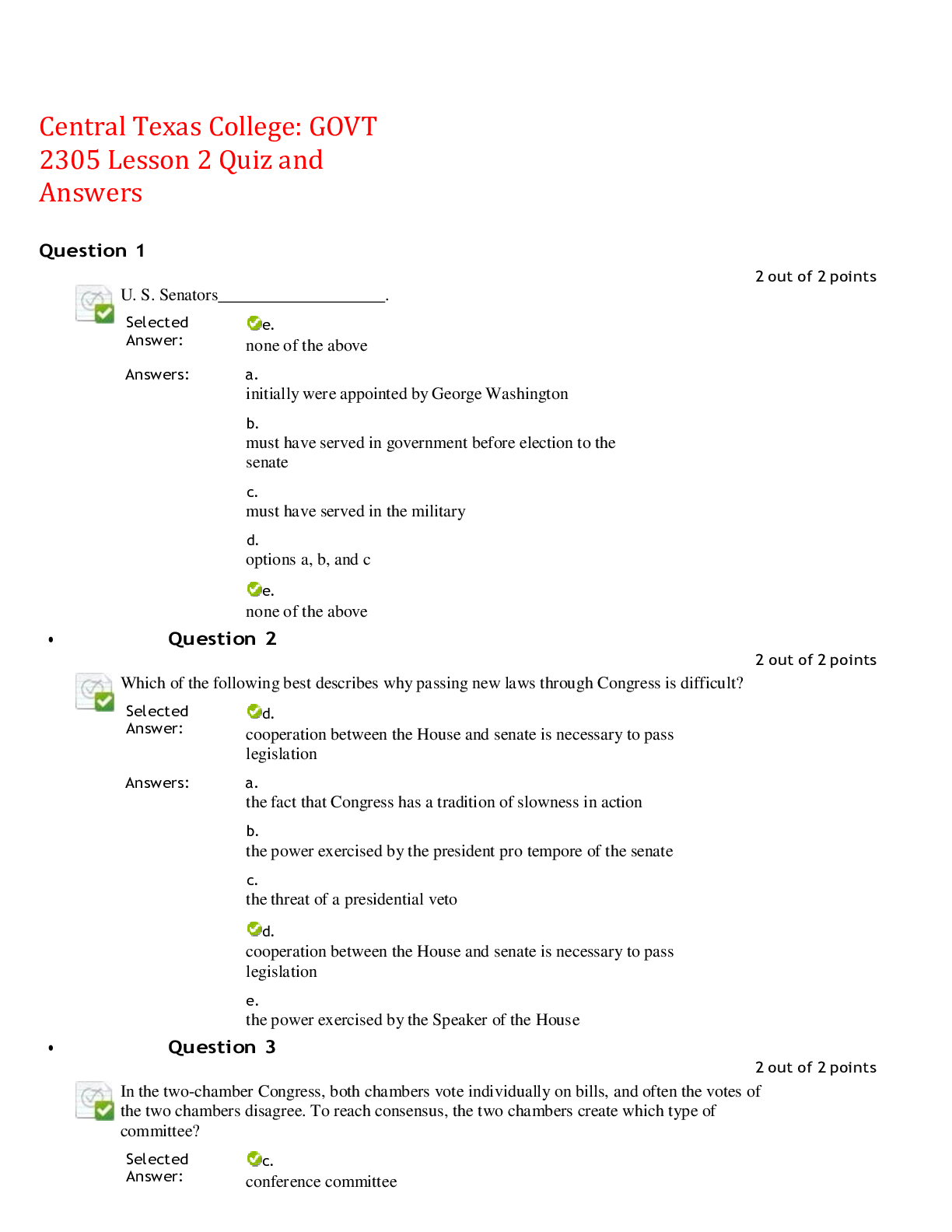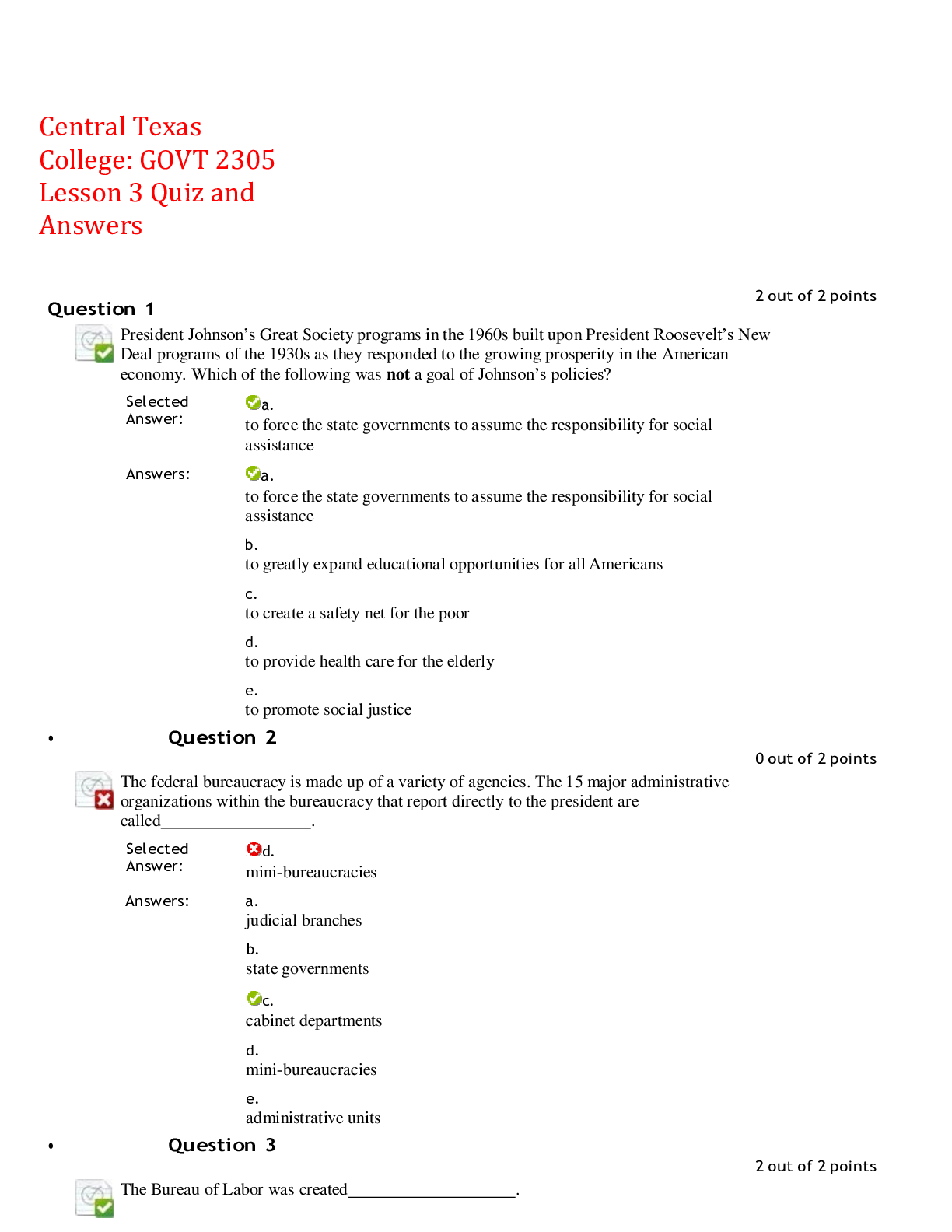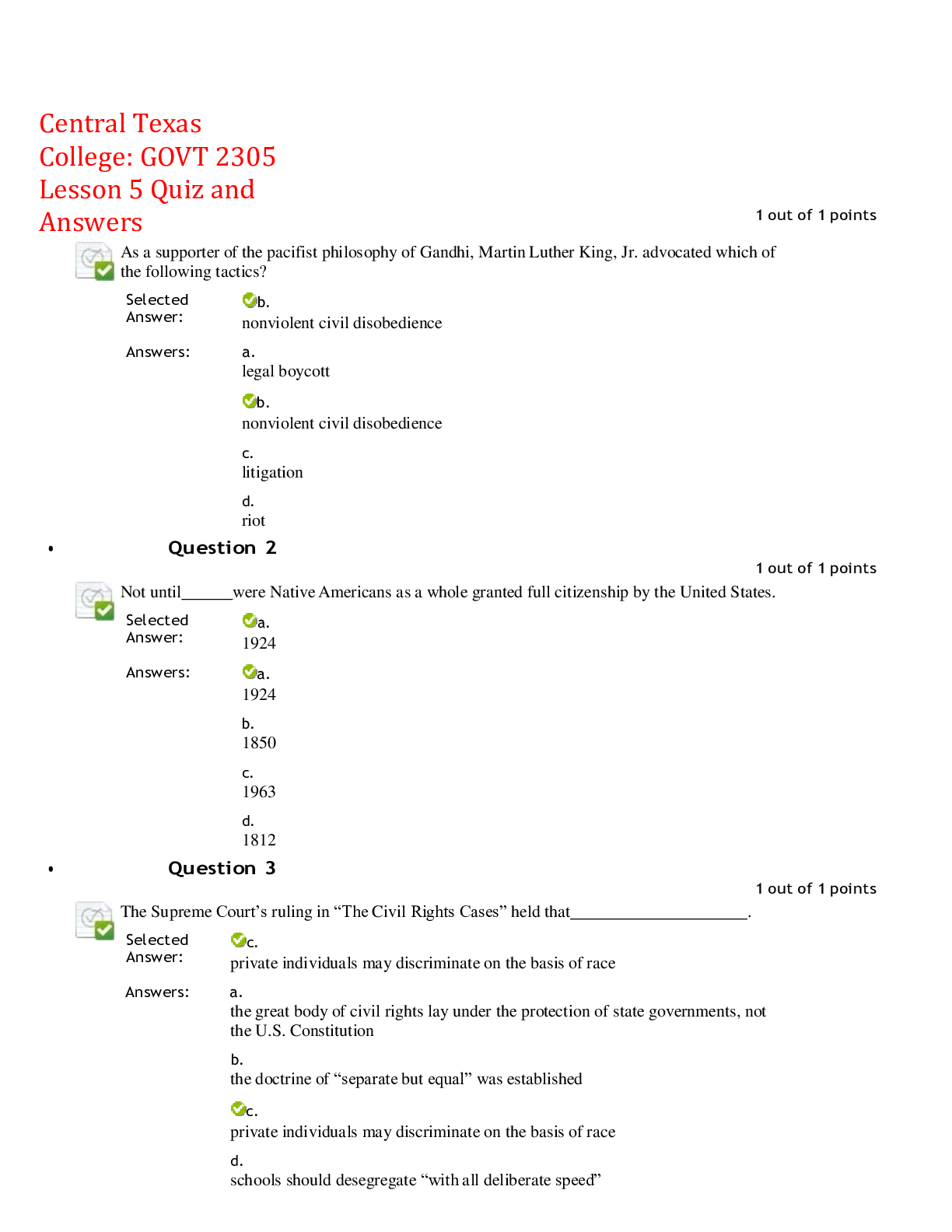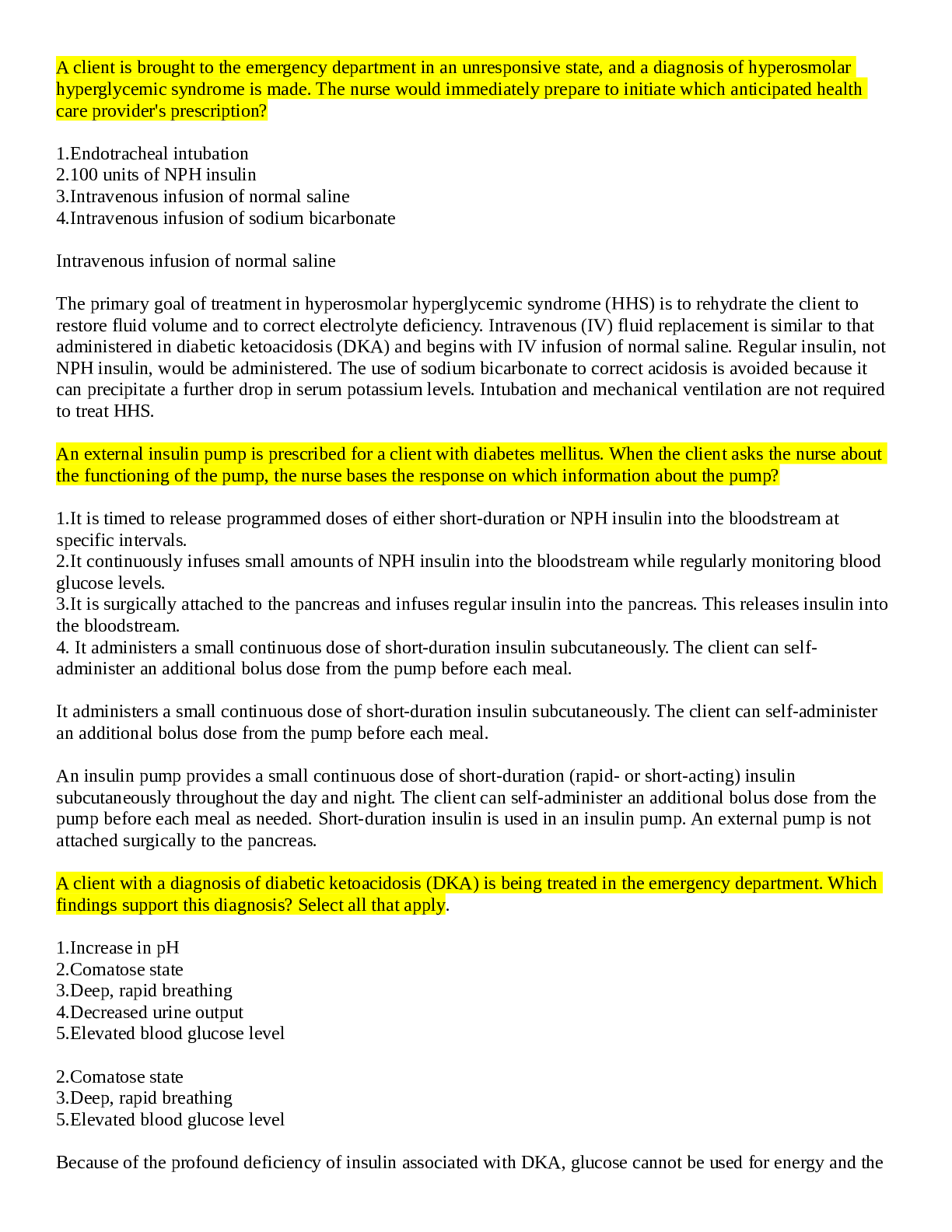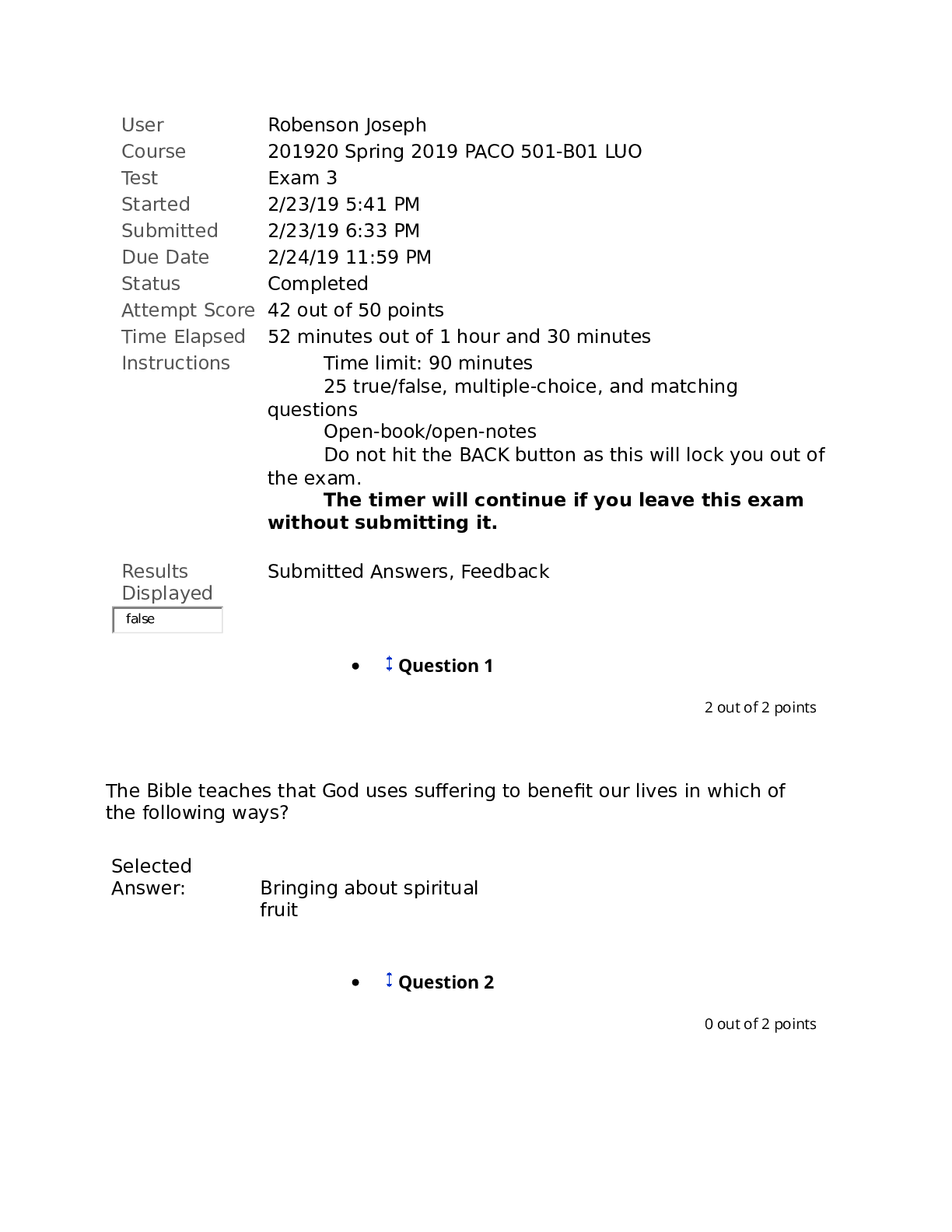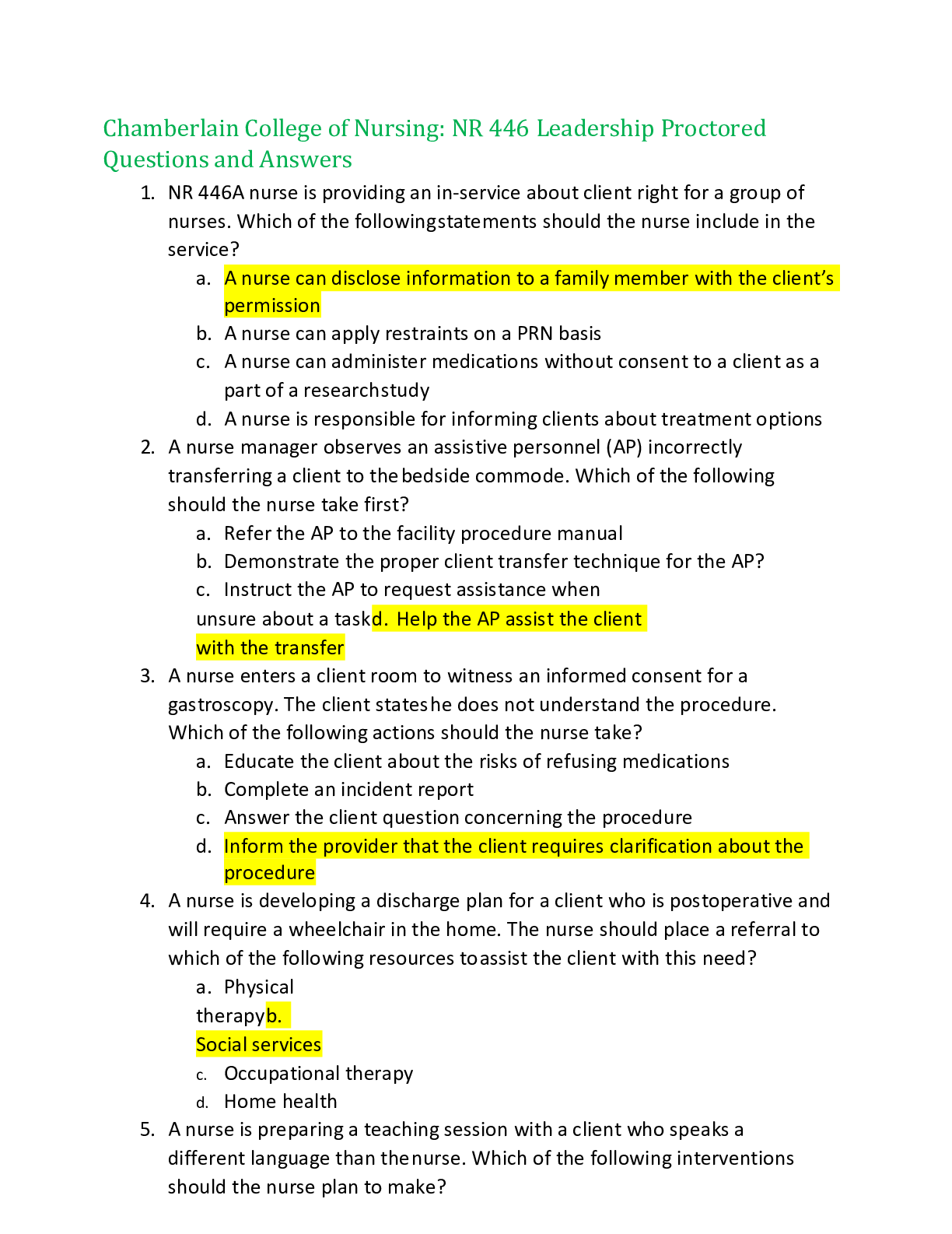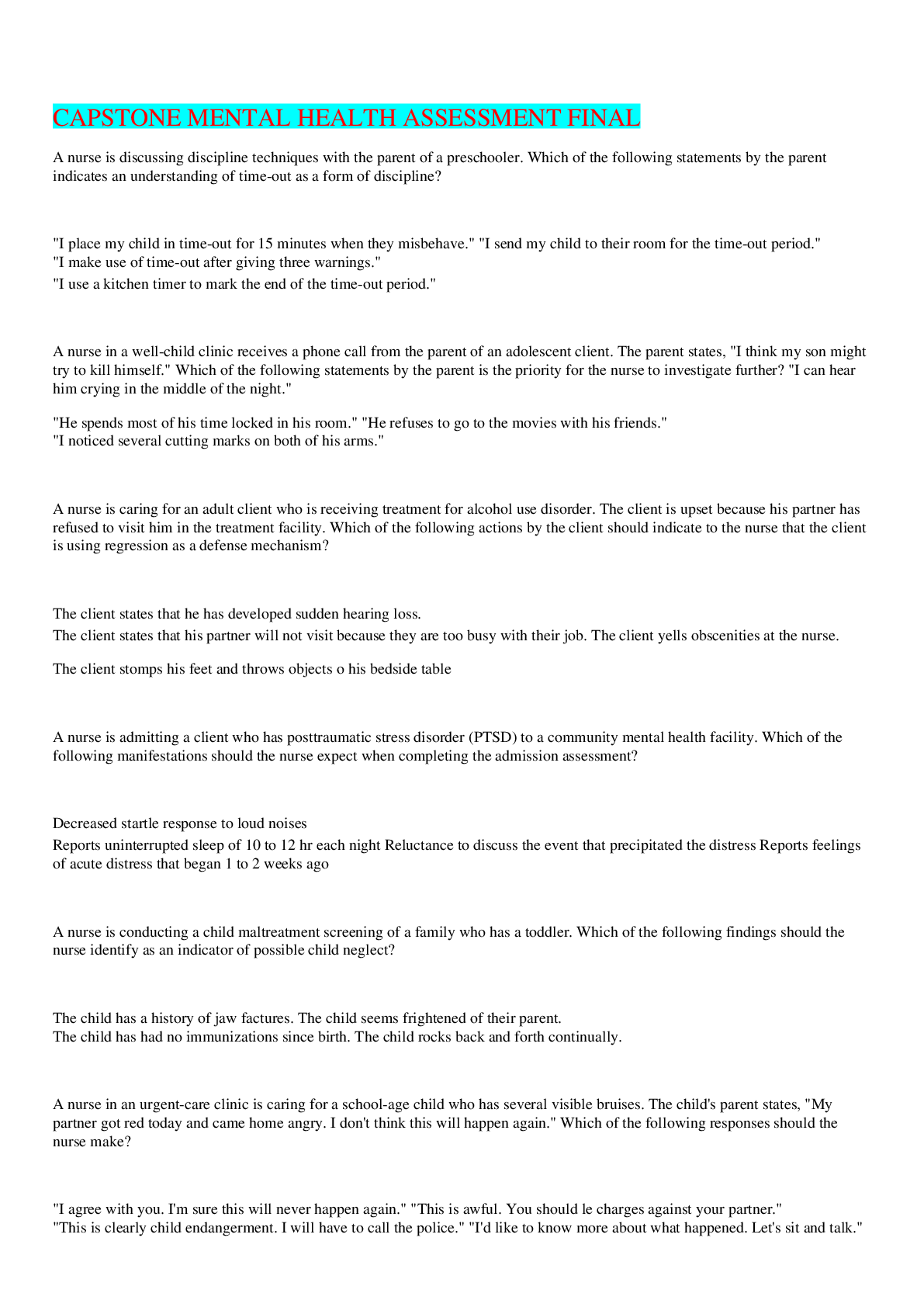MN 551 Quiz 3 and 4 Cardiovascular Questions and Answers,100% CORRECT
Document Content and Description Below
MN 551 Quiz 3 and 4 Cardiovascular Questions and Answers 3 - structure and function of the cardiovascular system 4 - structure and function of the respiratory system Question 1. The nurse prac... titioner for a cardiology practice is responsible for providing presurgical teaching for patients who are about to undergo a coronary artery bypass graft. Which of the following teaching points best conveys an aspect of the human circulatory system? “Your blood pressure varies widely between arteries and veins, and between pulmonary and systemic circulation.” Question 2. Which of the short term and long term compensatory mechanisms is least likely to decrease the symptoms of his heart failure? AV node pacemaking activity and vagal nerve suppression Question 3. A physical assessment of a 28-year-old female patient indicates that her blood pressure in her legs is lower than that in her arms and that her brachial pulse is weaker in her left arm than in her right. In addition, her femoral pulses are weak bilaterally. Which of the following possibilities would her care provider be most likely to suspect? (Points : 3) Coarctation of the aorta Question 4. As part of the diagnostic workup for a male patient with a complex history of cardiovascular disease, the care team has identified the need for a record of the electrical activity of his heart, insight into the metabolism of his myocardium, and physical measurements, and imaging of his heart. Which of the following series of tests is most likely to provide the needed data for his diagnosis and care? (Points : 3) Echocardiogram, PET scan, ECG Question 5. An older adult female patient has presented with a new onset of shortness of breath, and the patient's nurse practitioner has ordered measurement of her BNP levels along with other diagnostic tests. What is the most accurate rationale for the nurse practitioner's choice of blood work? (Points : 3) BNP is released as a compensatory mechanism during heart failure and measuring it can help differentiate the patient's dyspnea from a respiratory pathology. Question 6. A patient in the intensive care unit has a blood pressure of 87/39 and has warm, flushed skin accompanying his sudden decline in level of consciousness. The patient also has arterial and venous dilation and a decrease in systemic vascular resistance. What is this patient's most likely diagnosis? (Points : 3) Septic shock Question 7. A number of patients have presented to the emergency department in the last 24 hours with complaints that are preliminarily indicative of myocardial infarction. Which of the following patients is least likely to have an ST-segment myocardial infarction (STEMI)? (Points : 3) A 71-year-old man who has moist skin, fever, and chest pain that is excruciating when he moves but relieved when at rest Question 8. A 54-year-old man with a long-standing diagnosis of essential hypertension is meeting with his nurse practitioner. The patient's nurse practitioner would anticipate that which of the following phenomena is most likely occurring? (Points : 3) The conversion of angiotensin I to angiotensin II in his lungs causes increases in blood pressure and sodium reabsorption. Question 9. A 66-year-old obese man with a diagnosis of ischemic heart disease has been diagnosed with heart failure that his care team has characterized as attributable to systolic dysfunction. Which of the following assessment findings is inconsistent with his diagnosis? (Points : 3) Ventricular dilation and wall tension are significantly lower than normal. Question 10. Which of the following assessment findings in a newly admitted 30-year-old male patient would be most likely to cause his nurse practitioner to suspect polyarteritis nodosa? (Points : 3) The man's blood pressure is 178/102 and he has abnormal liver function tests Question 11. A 6-year-old boy has been brought to the emergency department by ambulance after his mother discovered that his heart rate was “so fast I couldn't even count it.” The child was determined to be in atrial flutter and his mother is seeking an explanation from the health care team. Which of the following points should underlie an explanation to the mother? (Points : 3) The child is experiencing a reentry rhythm in his right atrium. / Atrial Flutter Question 12. A patient has suffered damage to his pericardium following a motor vehicle accident. Which of the following consequences should the nurse practitioner be most likely to rule out? (Points : 3) Impaired regulation of myocardial contraction Question 13. Which of the following situations related to the transition from fetal to perinatal circulation would be most likely to necessitate medical intervention? (Points : 3) Pulmonary vascular resistance, related to muscle regression in the pulmonary arteries, rises over the course of the infant's first week. Question 14. A 70-year-old male patient presents to the emergency department complaining of pain in his calf that is exacerbated when he walks. His pedal and popliteal pulses are faintly palpable and his leg distal to the pain is noticeably reddened. What would his care provider's preliminary diagnosis and anticipated treatment most likely be? (Points : 3) Atherosclerotic occlusive disease necessitating thrombolytic therapy Question 15. A patient is experiencing impaired circulation secondary to increased systemic arterial pressure. Which of the following statements is the most relevant phenomenon? (Points : 3) High afterload because of backpressure against the left ventricle Question 16. A nurse practitioner is providing care for several patients on a medical unit of a hospital. In which of the following patient situations would the nurse practitioner be most likely to rule out hypertension as a contributing factor? (Points : 3) A 61-year-old man who has a heart valve infection and recurrent fever Question 17. A formerly normotensive woman, pregnant for the first time, develops hypertension and headaches at 26 weeks' gestation. Her blood pressure is 154/110 mm Hg and she has proteinuria. What other labs should be ordered for her? (Points : 3) Platelet count, serum creatinine, and liver enzymes Question 18. A nurse practitioner is instructing a group of older adults about the risks associated with high cholesterol. Which of the following teaching points should the participants try to integrate into their lifestyle after the teaching session? “Your family history of hypercholesterolemia is important, but there are things you can do to compensate for a high inherited risk.” Question 19. An autopsy is being performed on a 44-year-old female who died unexpectedly of heart failure. Which of the following components of the pathologist's report is most suggestive of a possible history of poorly controlled blood pressure? “Arterial sclerosis of subcortical brain regions noted.” Question 20. A nurse practitioner has ordered the measurement of a cardiac patient's electrolyte levels as part of the patient's morning blood work. Which of the following statements best captures the importance of potassium in the normal electrical function of the patient's heart? (Points : 3) Potassium is central to establishing and maintaining the resting membrane potential of cardiac muscle cells. Question 21. In which of the following patient situations would a nurse practitioner be most justified in preliminarily ruling out pericarditis as a contributing pathology to the patient's health problems? A 77-year-old with diminished S3 and S4 sounds, an irregular heart rate, and a history of atrial fibrillation Question 22. During a routine physical examination of a 66-year-old woman, her nurse practitioner notes a pulsating abdominal mass and refers the woman for further treatment. The nurse practitioner is explaining the diagnosis to the patient, who is unfamiliar with aneurysms. Which of the following aspects of the pathophysiology of aneurysms would underlie the explanation the nurse provides? Hypertension is a frequent modifiable contributor to aneurysms. Question 23. A 66-year-old patient's echocardiogram reveals a hypertrophied left ventricle, normal chamber volume, and a normal ejection fraction from the heart. What is this patient's most likely diagnosis? Aortic valve stenosis Question 24. A nurse practitioner is teaching a student NP about the physiologic basis for damage to the circulatory and neurological systems that can accompany hypotension. Which of the following responses by the student would warrant correction by the nurse practitioner? “Tension and vessel thickness increase proportionately.” Question 25. An 81-year-old female patient of a long-term care facility has a history of congestive heart failure. The nurse practitioner caring for the patient has positioned her sitting up at an angle in bed and is observing her jugular venous distention. Why is jugular venous distention a useful indicator for the assessment of the patient's condition? Blood backs up into the jugular vein because there are no valves at the point of entry into the heart. Question 26. A 22-year-old male is experiencing hypovolemic shock following a fight in which his carotid artery was cut with a broken bottle. What immediate treatments are likely to most benefit the man? Infusion of normal saline of Ringer lactate to maintain the vascular space Question 27. A 68-year-old male complains to his NP when he tests his blood pressure using a machine at his pharmacy, his HR is always low. He feels his heart racing and it seems to pause at times. He is lightheadedness and a recent syncopal episode. What is the patient’s diagnosis and the phenomenon underlying it? as a result of a disease of his sinus node and atrial or junctional arrhythmias. Question 28. A 77-year-old woman with a recent onset of syncopal episodes has been referred to a cardiologist by her family physician. As a part of the patient’s diagnostic work-up, the nurse practitioner conducting the intake assessment has ordered a Holter monitor for 24 hours. Which of the following statements best captures an aspect of Holter monitor? Accurate interpretation of the results requires correlating the findings with activity that the woman was doing at the time of recording. MN551 Quiz 4 1. Which of the following patients who presented to a walk-in medical clinic is most likely to be diagnosed with a rhinosinusitis rather than a common cold? Fever and facial pain are more commonly associated with rhinosinusitis rather than the common cold. The other noted symptoms are indicative of the common cold rather than rhinosinusitis. A man complaining of general fatigue, a headache, and facial pain with a temperature of 100.9° pg 929-930 A woman presenting with malaise, lethargy, and copious nasal secretions 98.9°F A man with a dry, stuffy nasopharynx, a sore throat, and temperature of A woman complaining of generalized aches who has a hoarse voice and reddened, painful upper airways Question 2.2. A 44-year-old woman developed calf pain during a transatlantic flight followed by acute shortness of breath upon arrival at her destination. She was subsequently diagnosed with a pulmonary embolism (PE), which resolved with anticoagulant therapy. Which of these statements best characterizes the underlying problem of her PE? Ventilation was occurring, but perfusion was inadequate causing shortness of breath. Impaired blood flow to a portion of the lung, such as with a PE, is associated with ventilation without perfusion, rather than perfusion without ventilation. The situation is not related to an anatomic shunt or impaired diffusion across alveolar membranes. She was short of breath because ventilation was occurring but perfusion was inadequate. Pg 984-985 The combination of normal perfusion but compromised ventilation caused hypoxia. She developed a transient anatomic shunt resulting in impaired oxygenation. Impaired gas diffusion across alveolar membranes resulted in dyspnea and hypoxia. Question 3.3. A premature infant on mechanical ventilation has developed bronchopulmonary dysplasia (BPD) and is showing signs and symptoms of hypoxemia, low lung compliance, and respiratory distress syndrome (RDS). Which of the following is the most likely contributor to the infant's present health problem? (Despite the administration of corticosteroids in utero to hasten alveolar maturation, premature infants suffering respiratory distress syndrome often must be treated with supplemental oxygen and mechanical ventilation. However, overly forceful positive-pressure ventilation (barotrauma) can lead to the chronic lung impairment of BPD. Surfactant therapy is a first-line defense against the development of RDS and is also used to treat cases of BPD; additional time on a ventilator is often required as well. High inspired oxygen concentration and injury from positive- pressure ventilation. Pg 952 Failure to administer corticosteroids to the infant in utero Insufficient surfactant production and insufficient surfactant therapy Insufficient supplemental oxygen therapy Question 4.4. Which of the following residents of a long-term care facility is most likely to be exhibiting the signs and symptoms of chronic obstructive pulmonary disease (COPD)? Productive cough and recurrent respiratory infections are associated with COPD, while pain, fever, and increased white cells are not common signs and symptoms of COPD. Acute shortness of breath and bronchoconstriction are associated with asthma. A 79-year-old lifetime smoker who is complaining of shortness of breath and pain on deep inspiration An 81-year-old smoker who has increased exercise intolerance, a fever, and increased white blood cells An 81-year-old male who has a productive cough and recurrent respiratory infections. pg 975 An 88-year-old female who experiences acute shortness of breath and airway constriction when exposed to tobacco smoke/ 5.5. A 66-year-old male presents to the emergency department accompanied by his wife who claims that he has been acting confused. The man is complaining of a sudden onset of severe weakness and malaise and has a dry cough and diarrhea. His temperature is 102.8°F and his blood work indicates his sodium level is 126 mEq/L (normal is 135 to 145 mEq/L). What will be the assessing nurse practitioner's most likely suspicion? Confusion, dry cough, diarrhea, and hyponatremia are associated with Legionnaire disease and less so with bronchopneumonia, Mycoplasma pneumonia, or pneumococcal pneumonia. Bronchopneumonia Mycoplasma pneumonia Legionnaire disease Pg. 938 Pneumococcal pneumonia Question 6.6. A 51-year-old female patient who is 2 days postoperative on a surgical unit of a hospital is at risk for developing atelectasis as a result of being largely immobile. Which of the following teaching points by her nurse practitioner is most appropriate? (Atelectasis is characterized by incomplete lung expansion and can often be prevented by deep breathing and coughing. Pleural effusion, not atelectasis, is associated with fluid accumulation between the lungs and their lining, and neither chest tube insertion nor bronchodilators are common treatments for atelectasis. “Being in bed increases the risk of fluid accumulating between your lungs and their lining, so it's important for you to change positions often.” “You should breathe deeply and cough to help your lungs expand as much as possible while you're in bed.” “Make sure that you stay hydrated and walk as soon as possible to avoid our having to insert a chest tube.” “I'll prescribe bronchodilator medications that will help open up your airways and allow more oxygen in.” Question 7.7. Due to complications, a male postoperative patient has been unable to mobilize for several days following surgery and has developed atelectasis. Which of the following processes would his care team anticipate with relation to his health problem? Regional hypoxia, such as with a diagnosis of atelectasis, is associated with vasoconstriction and redirection of blood away from, not toward, the affected area of the lung. This also contributes to an increased workload for the right side of the heart. Vasodilation in the alveolar vessels in the affected region of his lung Increased workload for the left side of the patient's heart Increased blood flow to the area of atelectasis Redirection of blood flow away from the lung regions that are hypoxic Question 8.8. Which of the following clinical findings would be most closely associated with a patient who has interstitial lung disease rather than COPD? (Because it takes less work to move air through the airways at an increased rate than it does to stretch a stiff lung to accommodate a larger tidal volume, interstitial lung disease is commonly associated with an increased respiratory rate but decreased tidal volume. Wheezing and decreased expiratory flow rate are more closely associated with COPD. Audible wheezing on expiration Diminished expiratory flow rates Increased respiratory rate with decreased tidal volume Normal compliance of alveolar tissue Question 9.9. A male lifetime smoker has died as a result of chronic obstructive pulmonary disease. Which of the following phenomena regarding his alveoli would his care team have most reasonably expected in the weeks prior to his death? Smokers often retain large numbers of carbon-filled macrophages in their septal connective tissue. NK cell proliferation is not a noted phenomenon in the alveoli, and tubercles are associated specifically with tuberculosis infection. Type I alveoli are incapable of regeneration. Proliferation of natural killer (NK) cells in the alveolar lumen Large numbers of alveolar macrophages in septal connective tissue The presence of tubercles in the intra-alveolar spaces Compensatory regeneration of type I alveolar cells Question 10.10. A 21-year-old male patient has suffered a head injury during a crash on his motorcycle, and a deficit that assessments have revealed is an impaired swallowing mechanism. He has also developed aspiration pneumonia. Which of the following statements most accurately capture an aspect of his condition? (The vocal folds contribute to blocking of the airways during swallowing; compromise to this function is likely to allow food to enter the lungs. The epiglottis is performing its normal, protective role against aspiration when it covers the larynx, and the vocal folds contribute to sound enunciation, not swallowing or protection against aspiration. Tracheobronchial obstruction would not contribute to aspiration. His oropharynx is obstructed. His epiglottis is covering his larynx His vocal folds have been compromised. His tracheobronchial tree is intermittently obstructed Question 11.11. A short, nonsmoking middle-aged man presents to the emergency department with left-sided chest pain and a cough. He says that the pain started abruptly, just after lunch, and that breathing and coughing make it worse. He denies recent injury. He is breathing shallowly and rapidly and expresses fear that he may be having a heart attack. Breath sounds are normal, and he is not cyanotic. Which condition is most likely causing his symptoms? Pleuritis, which frequently accompanies infections that cause cough, is unilateral, starts abruptly, and is worsened by coughing or deep breathing. The client's shallow, rapid breathing may be due to anxiety but also is a way of maintaining adequate air intake while avoiding deep breathing, which exacerbates the pain of pleuritis. His cough may be an indication of infection, especially as he is not a smoker. The pain of myocardial infarction is not worsened by deep breathing or coughing. Spontaneous pneumothorax would be very unlikely in a short, nonsmoking middle-aged man. Tachypnea might indicate obstructive atelectasis, but normal breath sounds and lack of cyanosis argue against it. Myocardial infarction Spontaneous pneumothorax Pleuritis related to infection Obstructive atelectasis Question 12.12. Which of the following statements best conveys an aspect of the respiratory pressures that govern ventilation? Negative intrapleural pressure holds the lungs in place against the chest wall and prevents their natural elastic properties from causing them to collapse. Intrapleural pressure is negative in relation to the inflated lung, and the chest wall exerts negative pressure on the lungs that keeps them from contracting and contributes to inspiration. Intrapulmonary pressure oscillates between positive and negative relative to atmospheric pressure with expiration and inspiration. Intrapleural pressure slightly exceeds that of the inflated lung The chest wall exerts positive pressure on the lungs that contributes to expiration The lungs are prevented from collapsing by constant positive intrapulmonary pressure Negative intrapleural pressure holds the lungs against the chest wall Question 13.13. The mother of a 7-year-old boy who has recently been diagnosed with childhood asthma has come to the education center to learn more about her son's condition. Which of the following teaching points is most justifiable? Viruses have been implicated as a contributing factor in childhood asthma. Wheezing may or may not be present in children, and inhaled corticosteroids are not common as an initial therapy. Current treatment guidelines do not advise the categorical avoidance of exercise. “Research has shown that viruses may actually be a factor in many children's asthma.” “The most reliable indicator that your child is having an asthma attack is audible wheezing.” “Steroids that your child can inhale will likely be the first line of defense. “Your son will likely need to limit or avoid exercise and sports.” Question 14.14. Which of the following phenomena is most likely occurring during a child's alveolar stage of lung development? During the alveolar stage of lung development from late fetal to early childhood, a single capillary network appears, and the lungs are ready to perform respiration. The development of alveolar sacs and production of surfactant are associated with the saccular period, and formation of the conducting airways occurs during the pseudoglandular period. Formation of primitive alveoli takes place during the canalicular period. Terminal alveolar sacs are developing and surfactant production is beginning. A single-capillary network exists and the lungs are capable of respiration. The conducting airways are formed, but respiration is not yet possible. Primitive alveoli are formed and the bronchi and bronchioles become much larger. Question 15.15. A 71-year-old woman is dependent on oxygen therapy and bronchodilators due to her diagnosis of emphysema. Which of the following processes would her care team be most justified in ruling out? In lung pathology, such as emphysema, large amounts of air are trapped at the end of a given breath, a situation that corresponds to increased residual volume and decreased vital capacity. Elastic recoil would tend to suffer, and both alveolar and anatomical dead space consequently increase. Decreased elastic recoil due to alveolar damage Decreased residual lung volume due to impaired alveolar ventilation Increased anatomic dead space due to reduced tidal volume Increased alveolar dead space due to incorrect intrapleural pressure Question 16.16. A definitive test for cystic fibrosis is? If a genetic test or blood test suggests CF, a doctor will confirm the diagnosis using a sweat test. This test is the most useful test for diagnosing CF. A sweat test measures the amount of salt in sweat. The sweat test ------- A sputum culture A fecal fat test A Chymex test for pancreatic insufficiency Question 17.17. A patient who presented with shortness of breath and difficulty climbing stairs has been diagnosed with pulmonary fibrosis, a disease characterized by scarring of the alveoli. What would her care team anticipate when observing her breathing? Scarring diminishes the elasticity of the lung tissue, resulting in noncompliant lungs that are more difficult to inflate. In order to maintain a sufficient tidal volume and oxygen level with the lungs that require extra work to expand, the individual must take shallower, more rapid breaths. The effort and time required for him to breathe deeply would detract from his ability to bring in enough air. Rapid, deep breaths - Wheezing breaths - Short, shallow breaths - Pursed-lip breaths Question 18.18. Which of the following patients are NOT displaying known risk factors for the development of pulmonary emboli? Postsurgical immobility, smoking, and the use of oral contraceptives are all identified risk factors for the development of pulmonary emboli. Impaired Cl- and Na+ regulation are associated with cystic fibrosis, while amiodarone and radiation therapy are linked to interstitial lung diseases A patient who is immobilized following orthopedic surgery A patient who has impaired Cl– and Na+ regulation A patient who is taking amiodarone for the treatment of a cardiac arrhythmia A patient who is a smoker and takes oral contraceptive A patient who is undergoing radiation therapy for the treatment of breast cancer Question 19.19. Following a winter power outage, a patient who had been using a home gasoline generator began to experience dizziness and headaches and was diagnosed with carbon monoxide poisoning. What is the goal of hyperbaric oxygen treatment for carbon monoxide poisoning? While increased alveolar PO2 improves the oxygen saturation of hemoglobin, carbon monoxide occupies the hemoglobin sites usually available for oxygen. With much of the blood composed, temporarily, of carboxyhemoglobin, it is necessary to rely upon alternate means to deliver oxygen to the tissues. Plasma's normally low carrying capacity for dissolved oxygen can be increased by administration of 100% oxygen in the high atmospheric pressure of a hyperbaric chamber. To increase the amount of oxygen dissolved in plasma To increase the production of unbound hemoglobin To stimulate the release of oxygen at the capillaries To remove bound CO from hemoglobin Question 20.20. A nurse practitioner is performing patient teaching about the influenza virus with each patient who has come to the clinic to receive that year's vaccine. Which of the following statements by patients best reflects an accurate understanding of the flu virus? Viral and bacterial pneumonia are known sequelae of influenza. Antiviral drugs do exist for the flu, and the efficacy of staying warm and increasing fluid consumption have been demonstrated. The flu vaccine is recommended for higher risk individuals, and guidelines do not indicate the need for all individuals to be vaccinated. “I could come down with viral or bacterial pneumonia as a result of a bad flu bug.” “I know my vaccination is especially important since there aren't any drugs that can treat the flu once I get sick with it.” “The emphasis on bundling up, staying warm, and drinking lots of fluids is outdated and actually ineffective.” “Like all vaccines, it is ideal if everyone in a population gets immunized against the flu.” Question 21.21. A 77-year-old lifetime smoker has been diagnosed with a tumor in his lung at the site of an old tubercle scarring site, located in a peripheral area of his bronchiolar tissue. What is this patient's most likely diagnosis? Adenocarcinoma is associated with the periphery of the lungs, often at the site of scarring, and can occur in alveolar or bronchiolar tissue. Squamous cell carcinoma, small cell lung cancer, and large cell carcinoma are less commonly associated with these traits. Squamous cell carcinoma Small cell lung cancer Large cell carcinoma Adenocarcinoma Question 22.22. As a result of dehydration, a patient's epithelial cells are producing insufficient amounts of mucus. Consequently, the patient's mucociliary blanket is compromised. Which of the following changes would a care provider most reasonably anticipate as a direct result of this change? The primary role of the mucociliary blanket is to trap foreign particles and bacteria and thus prevent their entry into the lungs. Impaired ciliary function may result in an inadequate mucociliary blanket, but the opposite relationship is unlikely. Decreased oxygen and increased carbon dioxide levels may eventually result, but not as a direct or immediate consequence. Impaired function of the patient's cilia Decreased levels of oxygen saturation Increased amounts of bacteria in the lung Increased carbon dioxide levels Question 23.23. Which of the following statements best captures the etiology of the acute response phase of extrinsic (atopic) asthma? The acute response phase of extrinsic asthma is characterized by the release of chemical mediators from mast cells that have been sensitized. Epithelial injury and edema, as well as airway remodeling, are not associated with the acute phase, and IgE, not IgG, is primarily involved in asthma. allergen. function. IgG production is heightened as a consequence of exposure to an Airway remodeling results in airflow limitations. Epithelial injury and edema occur along with changes in mucociliary Chemical mediators are released from presensitized mast cells. Question 24.24. A 62-year-old female smoker is distraught at her recent diagnosis of small cell lung cancer (SCLC). How can her nurse practitioner most appropriately respond to her? Metastases are common with SCLC. Survival rates are very low; surgical options do not exist; and remission is very unlikely. “I'm sure this is very hard news to hear, but be aware that with aggressive treatment your chances of beating this are quite good.” “This is very difficult to hear, I'm sure, and we have to observe to see if it spreads because that often happens.” “I'm very sorry to have to give you this news; I'd like to talk to you about surgical options, however.” “This is a difficult diagnosis to receive, but there is a chance that the cancer may go into remission.” Question 25.25. About 3 weeks after razing an old chicken house, a 71-year- old retired farmer has developed a fever, nausea, and vomiting. After ruling out more common health problems, his care provider eventually makes a diagnosis of histoplasmosis. Which of the following processes is most likely taking place? Disseminated histoplasmosis results from the inability of macrophages of the reticuloendothelial system to destroy the fungi. Fungi do not produce toxins, and antibody production and autoimmune responses are not involved in the pathophysiology of this fungal infection. Toxin production by Histoplasma capsulatum is triggering an immune response. Antibody production against the offending fungi is delayed by the patient's age and the virulence of the organism. Spore inhalation initiates an autoimmune response that produces the associated symptoms. Macrophages are able to remove the offending fungi from the bloodstream but can't destroy them. 26. Which of the following situations would be most deserving of a pediatrician’s attention? Retraction and grunting indicate a significant increase in the work of breathing that can be indicative of respiratory distress syndrome, a situation that would require medical intervention. Periods of hyperventilation interspersed with reduced breathing rates are common during the transition to postpartum ventilation, and infants are commonly unable to mouth breathe. Nostril flaring could be a sign of dyspnea, but it can also be a compensatory mechanism that the infant uses to increase oxygen intake; this situation would not be considered as serious as an infant who has chest retractions and grunting. A) The mother of an infant 2 days postpartum notes that her baby has intermittent periods of hyperventilation followed by slow respirations or even brief periods of apnea. B) A volunteer in the nursery notes that one of the infants, aged 2 weeks, appears unable to breathe through his mouth, even when his nose is congested. C) A neonate is visibly flaring her nostrils on inspiration. D) A midwife notes that a newborn infant's chest is retracting on inspiration and that the child is grunting. 27. A female patient is requiring supplementary oxygen by facemask due to her reduced lung compliance. Which of the following pathophysiological processes is most likely a contributor to her low lung compliance? Impaired thoracic cage flexibility can be a contributor to reduced lung compliance. Increased recoil and a modest excess of surfactant would increase lung compliance, and turbulent flow in the airways is a normal, not pathological, finding. A)The woman's lungs have more recoil than a healthy person's. B) Her type II alveolar cells are producing a slight excess of surfactant. C) Turbulent airflow is taking place in the patient's large airways. D) Her thoracic cage is less flexible than when she was healthy. 28). As a consequence of long-standing lung disease, a patient is in a chronic state of hypoxia. Which of the following phenomena would the patient’s nurse practitioner be most justified in anticipating? Increased production of erythropoietin, hyperventilation, and cognitive and personality changes are all associated with hypoxemia. Acidosis, not alkalosis, and vasoconstriction rather than vasodilation are likely to occur Metabolic alkalosis B) Increased erythropoietin production C) Pulmonary vasodilation D) Hyperventilation E) Personality changes 29). A 3 yr old boy has developed croup following a winter cold. His nurse practitioner would recognize that which of the following causative microoganisms and treatments are most likely? The majority of croup cases are caused by parainfluenza viruses, and common treatment modalities are humidified air or mist tents as well as supplementary oxygen. Respiratory syncytial virus accounts for some croup diagnoses, but intubation is not normally required. Haemophilus influenza is responsible for epiglottitis, while Staphylococcus aureus is not commonly responsible for croup. Respiratory syncytial virus treated with intubation B) Parainfluenza virus treated with a mist tent and oxygen therapy C) Haemophilus influenza treated with appropriate antibiotics D) Staphylococcus aureus treated with bronchodilators and mist tent [Show More]
Last updated: 1 year ago
Preview 1 out of 34 pages
.png)
Reviews( 0 )
Document information
Connected school, study & course
About the document
Uploaded On
Sep 30, 2021
Number of pages
34
Written in
Additional information
This document has been written for:
Uploaded
Sep 30, 2021
Downloads
0
Views
29




